Visible-broadband Localized Vector Vortex Beam Generator with a Multi-structure-composited Meta-surface
Abstract
1. Introduction
2. Materials and Methods
3. Results and Discussions
4. Conclusions
- The miniature material is just a few microns in size and the working part is only a few hundred nanometers thick. The side-length of the working part is less than 1500 nm. Moreover, the working part is approximately 135 nm thick.
- With the incidence of the linearly polarized beam, the meta-surface generates high-localized vector vortex beam with a high proportion of the longitudinal component. Being compared with the constituent part of the meta-surface, the multi-structure-combined meta-surface increases the localization by 250% and the longitudinal component proportion by 200%.
- The material can generate vortex beams in broadband within the visible light range. The results confirm that the devices can produce localized vector vortex beam in broadband, which provides the guidance for the excitation and utilization of localized vector vortex light beams generated by complex meta-surfaces above.
- Those above novel optical properties have the significantly potential to improve the precision and sensitivity of nanoparticle manipulation. The study serves as a foundation in optical miniaturization and integration, nanoparticle manipulation, high-efficiency optical and quantum communication, and light-driven micro-tools.
Author Contributions
Funding
Acknowledgments
Conflicts of Interest
Appendix A
References
- Gao, H.; Li, Y.; Chen, L.; Jin, J.; Pu, M.; Li, X.; Gao, P.; Wang, C.; Luo, X.; Hong, M. Quasi-Talbot effect of orbital angular momentum beams for generation of optical vortex arrays by multiplexing metasurface design. Nanoscale 2018, 10, 666–671. [Google Scholar] [CrossRef]
- Li, S.; Shen, B.; Zhang, X.; Bu, Z.; Gong, W. Conservation of orbital angular momentum for high harmonic generation of fractional vortex beams. Opt. Express 2018, 26, 23460–23470. [Google Scholar] [CrossRef] [PubMed]
- Jiang, S.; Chen, C.; Zhang, H.; Chen, W. Achromatic electromagnetic metasurface for generating a vortex wave with orbital angular momentum (OAM). Opt. Express 2018, 26, 6466–6477. [Google Scholar] [CrossRef]
- Devlin, R.C.; Ambrosio, A.; Rubin, N.A.; Mueller, J.B.; Capasso, F. Arbitrary spin-to–orbital angular momentum conversion of light. Science 2017, 358, 896–901. [Google Scholar] [CrossRef] [PubMed]
- Yeom, J.; Yeom, B.; Chan, H.; Smith, K.W.; Dominguez-Medina, S.; Bahng, J.H.; Zhao, G.; Chang, W.S.; Chang, S.J.; Chuvilin, A. Chiral templating of self-assembling nanostructures by circularly polarized light. Nat. Mater. 2014, 14, 66–72. [Google Scholar] [CrossRef] [PubMed]
- Yang, Z.; Saleh, A.A.E.; Haar, M.A.V.D.; Baum, B.; Briggs, J.A.; Lay, A.; Reyesbecerra, O.A.; Dionne, J.A. Nanoscopic control and quantification of enantioselective optical forces. Nat. Nanotechnol. 2017, 12, 1055–1060. [Google Scholar]
- Syubaev, S.; Zhizhchenko, A.; Kuchmizhak, A.; Porfirev, A.; Pustovalov, E.; Vitrik, O.; Kulchin, Y.; Khonina, S.; Kudryashov, S. Direct laser printing of chiral plasmonic nanojets by vortex beams. Opt. Express 2017, 25, 10214–10223. [Google Scholar] [CrossRef] [PubMed]
- Wang, J. Advances in communications using optical vortices. Photon. Res. 2016, 4, B14–B28. [Google Scholar] [CrossRef]
- Ndagano, B.; Nape, I.; Cox, M.A.; Rosales-Guzman, C.; Forbes, A. Creation and detection of vector vortex modes for classical and quantum communication. J. Lightwave Technol. 2018, 36, 292–301. [Google Scholar] [CrossRef]
- Han, Y.; Liu, Y.G.; Wang, Z.; Huang, W.; Chen, L.; Zhang, H.W.; Yang, K. Controllable all-fiber generation/conversion of circularly polarized orbital angular momentum beams using long period fiber gratings. Nanophotonics 2018, 7, 287–293. [Google Scholar] [CrossRef]
- Yan, X.; Guo, L.; Cheng, M.; Li, J. Controlling abruptly autofocusing vortex beams to mitigate crosstalk and vortex splitting in free-space optical communication. Opt. Express 2018, 26, 12605–12619. [Google Scholar] [CrossRef]
- Ding, D.S.; Zhang, W.; Zhou, Z.Y.; Shi, S.; Xiang, G.Y.; Wang, X.S.; Jiang, Y.K.; Shi, B.S.; Guo, G.C. Quantum storage of orbital angular momentum entanglement in an atomic ensemble. Phys. Rev. Lett. 2015, 114, 050502. [Google Scholar] [CrossRef] [PubMed]
- Nicolas, A.; Veissier, L.; Giner, L.; Giacobino, E.; Maxein, D.; Laurat, J. A quantum memory for orbital angular momentum photonic qubits. Nat. Photon. 2014, 8, 234–238. [Google Scholar] [CrossRef]
- Villangca, M.J.; Palima, D.; Bañas, A.R.; Glückstad, J. Light-driven micro-tool equipped with a syringe function. Light Sci. Appl. 2016, 5, e16148. [Google Scholar] [CrossRef] [PubMed]
- Ruffato, G.; Massari, M.; Romanato, F. Generation of high-order Laguerre-Gaussian modes by means of spiral phase plates. Opt. Lett. 2014, 39, 5094–5097. [Google Scholar] [CrossRef]
- Xin, J.; Dai, K.; Zhong, L.; Na, Q.; Gao, C. Generation of optical vortices by using spiral phase plates made of polarization dependent devices. Opt. Lett. 2014, 39, 1984–1987. [Google Scholar] [CrossRef]
- Forbes, A.; Dudley, A.; Mclaren, M. Creation and detection of optical modes with spatial light modulators. Adv. Opt. Photon. 2016, 8, 200–227. [Google Scholar] [CrossRef]
- Forbes, A.; Rosalesguzmán, C.; Bhebhe, N. Simultaneous generation of multiple vector beams on a single SLM. Opt. Express 2017, 25, 25697–25706. [Google Scholar]
- Guillon, M.; Forget, B.C.; Foust, A.J.; De, S.V.; Ritschmarte, M.; Emiliani, V. Vortex-free phase profiles for uniform patterning with computer-generated holography. Opt. Express 2017, 25, 12640–12652. [Google Scholar] [CrossRef]
- Ronzitti, E.; Ventalon, C.; Canepari, M.; Forget, B.C.; Papagiakoumou, E.; Emiliani, V. Recent advances in patterned photostimulation for optogenetics. J. Opt. 2017, 19, 113001. [Google Scholar] [CrossRef]
- Shi, F.; Qiu, M.; Zhang, L.; Lam, E.Y.; Lei, D.Y. Multi-plane Illumination Enabled by Fourier-Transform Metasurfaces for High-Speed Light-Sheet Microscopy. ACS Photonics 2018, 5, 1676–1684. [Google Scholar] [CrossRef]
- Shen, F.; Kang, Q.; Wang, J.; Guo, K.; Zhou, Q.; Guo, Z. Dielectric Metasurface-Based High-Efficiency Mid-Infrared Optical Filter. Nanomaterials 2018, 8, 938. [Google Scholar] [CrossRef] [PubMed]
- Chen, J.; Wang, K.; Long, H.; Han, X.; Hu, H.; Liu, W.; Wang, B.; Lu, P. Tungsten Disulfide-Gold Nanohole Hybrid Metasurfaces for Nonlinear Metalenses in the Visible Region. Nano Lett. 2018, 18, 1344–1350. [Google Scholar] [CrossRef] [PubMed]
- Guo, Z.; Xu, H.; Guo, K.; Shen, F.; Zhou, H.; Zhou, Q.; Gao, J.; Yin, Z. High-Efficiency Visible Transmitting Polarizations Devices Based on the GaN Metasurface. Nanomaterials 2018, 8, 333. [Google Scholar] [CrossRef] [PubMed]
- Shibanuma, T.; Maier, S.A.; Albella, P. Polarization control of high transmission/reflection switching by all-dielectric metasurfaces. Appl. Phys. Lett. 2018, 112, 063103. [Google Scholar] [CrossRef]
- Lin, D.; Fan, P.; Hasman, E.; Brongersma, M.L. Dielectric gradient metasurface optical elements. Science 2014, 345, 298–302. [Google Scholar] [CrossRef] [PubMed]
- Yue, F.; Wen, D.; Xin, J.; Gerardot, B.D.; Li, J.; Chen, X. Vector Vortex Beam Generation with a Single Plasmonic Metasurface. ACS Photonics 2016, 3, 1558–1563. [Google Scholar] [CrossRef]
- Liu, Y.; Ke, Y.; Zhou, J.; Liu, Y.; Luo, H.; Wen, S.; Fan, D. Generation of perfect vortex and vector beams based on Pancharatnam-Berry phase elements. Sci. Rep. 2017, 7, 44096. [Google Scholar] [CrossRef]
- Wintz, D.; Ambrosio, A.; Zhu, A.Y.; Genevet, P.; Capasso, F. Anisotropic surface plasmon polariton generation using bimodal V-antenna based metastructures. ACS Photonics 2016, 4, 22–27. [Google Scholar] [CrossRef]
- Kim, H.; Park, J.; Cho, S.W.; Lee, S.Y.; Kang, M.; Lee, B. Synthesis and dynamic switching of surface plasmon vortices with plasmonic vortex lens. Nano Lett. 2010, 10, 529–536. [Google Scholar] [CrossRef]
- Zilio, P.; Parisi, G.; Garoli, D.; Carli, M.; Romanato, F. Bi-layer holey plasmonic vortex lenses for the far field transmission of pure orbital angular momentum light states. Opt. Lett. 2014, 39, 4899–4902. [Google Scholar] [CrossRef] [PubMed]
- Chen, C.F.; Ku, C.T.; Tai, Y.H.; Wei, P.K.; Lin, H.N.; Huang, C.B. Creating Optical Near-Field Orbital Angular Momentum in a Gold Metasurface. Nano Lett. 2015, 15, 2746–2750. [Google Scholar] [CrossRef]
- Li, J.; Mu, J.; Wang, B.; Ding, W.; Liu, J.; Guo, H.; Li, W.; Gu, C.; Li, Z.Y. Direct laser writing of symmetry-broken spiral tapers for polarization-insensitive three-dimensional plasmonic focusing. Laser Photon. Rev. 2014, 8, 602–609. [Google Scholar] [CrossRef]
- Garoli, D.; Zilio, P.; Gorodetski, Y.; Tantussi, F.; De Angelis, F. Beaming of helical light from plasmonic vortices via adiabatically tapered nanotip. Nano Lett. 2016, 16, 6636–6643. [Google Scholar] [CrossRef]
- Cheng, F.; Kuang, D.F.; Dong, L.Q.; Cao, Y.Y.; Gu, P.C. Tuning of nanofocused vector vortex beam of metallic granary-shaped nanotip with spin-dependent dielectric helical cone. Opt. Express 2017, 25, 17393–17401. [Google Scholar] [CrossRef] [PubMed]
- Yang, Z.; Kuang, D.F.; Cheng, F. Vector vortex beam generation with dolphin-shaped cell meta-surface. Opt. Express 2017, 25, 22780–22788. [Google Scholar] [CrossRef] [PubMed]
- Luo, X.G. Principles of electromagnetic waves in metasurfaces. Sci. China Phys. Mech. Astron. 2015, 58, 594201. [Google Scholar] [CrossRef]
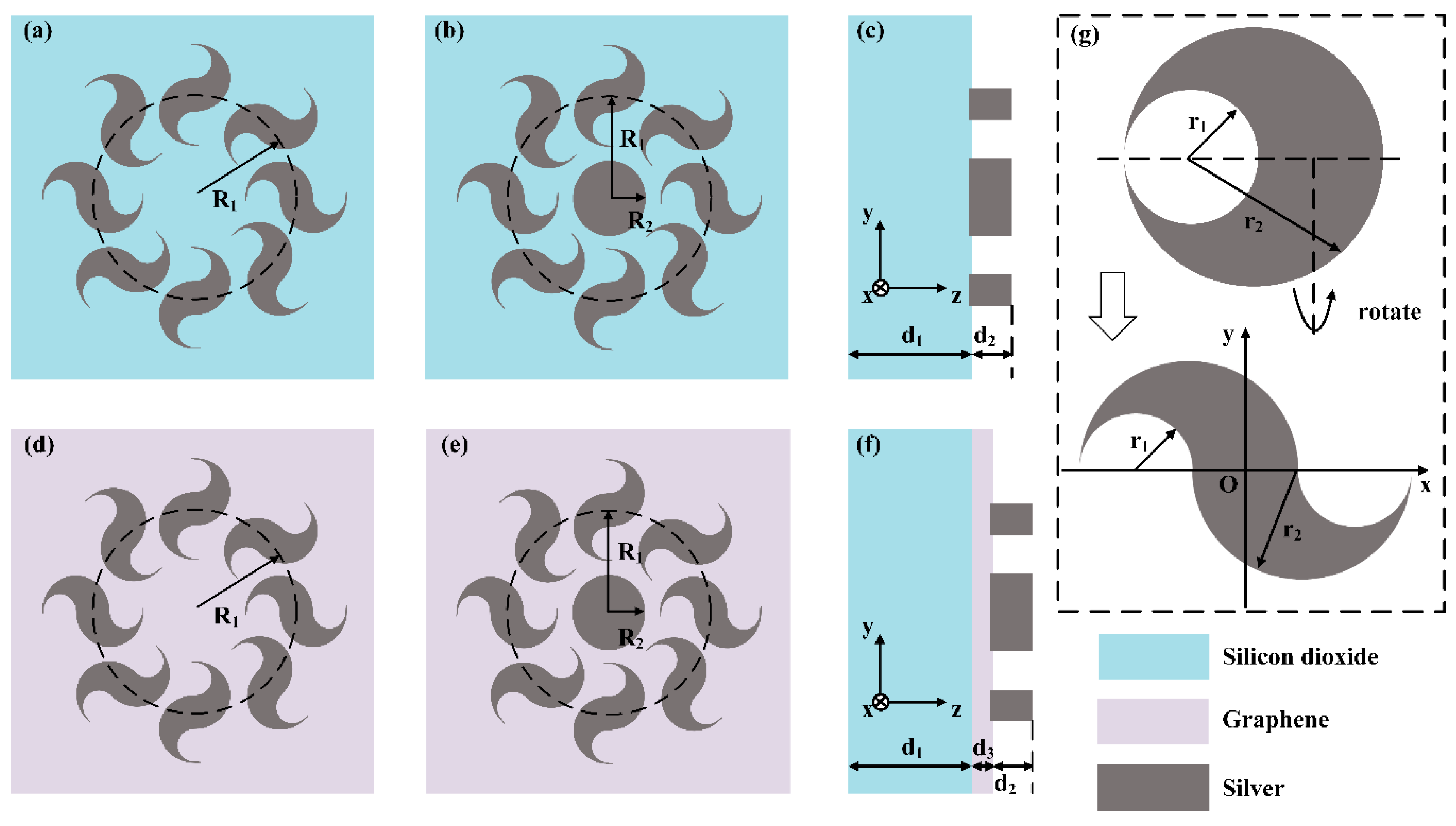
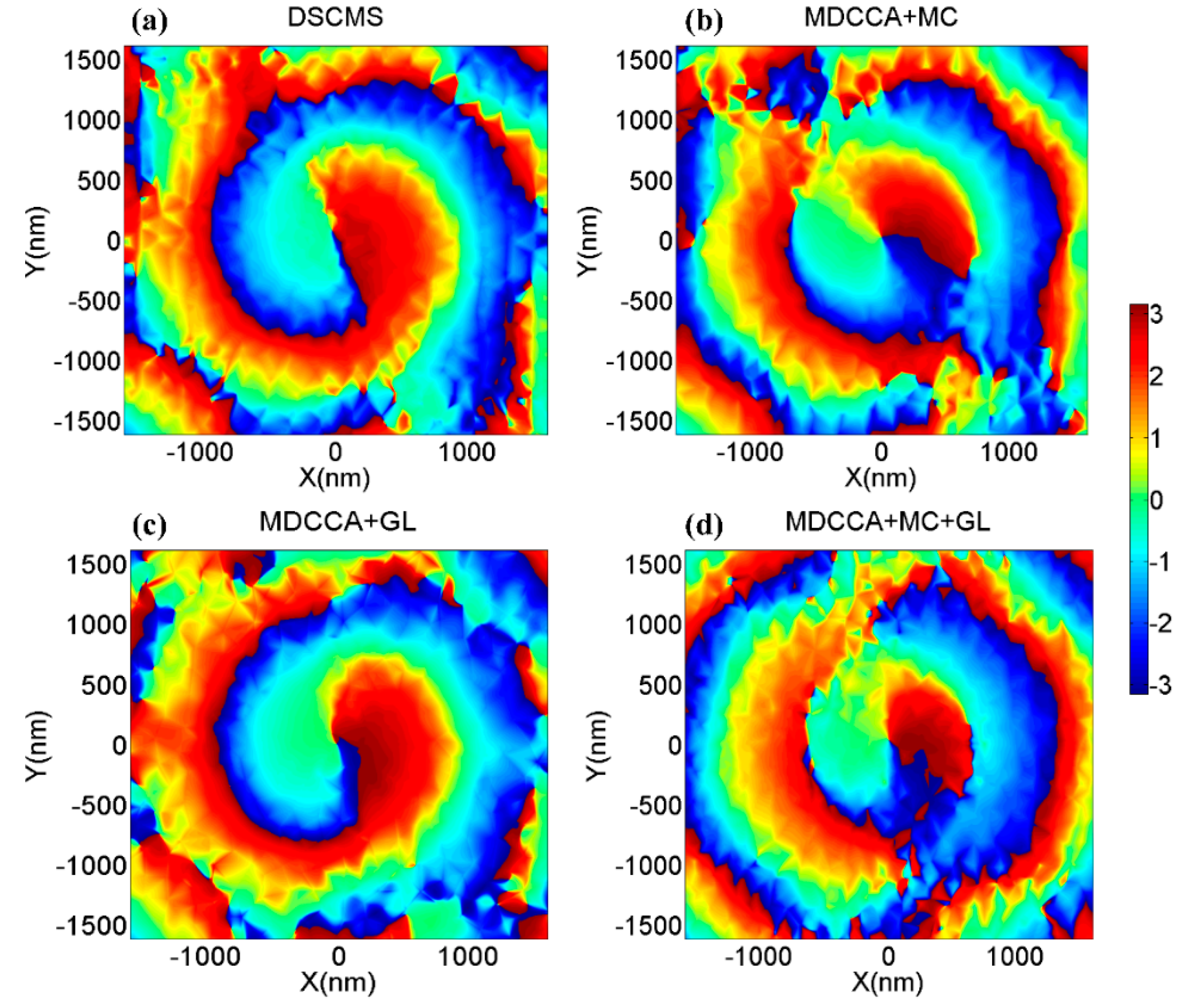
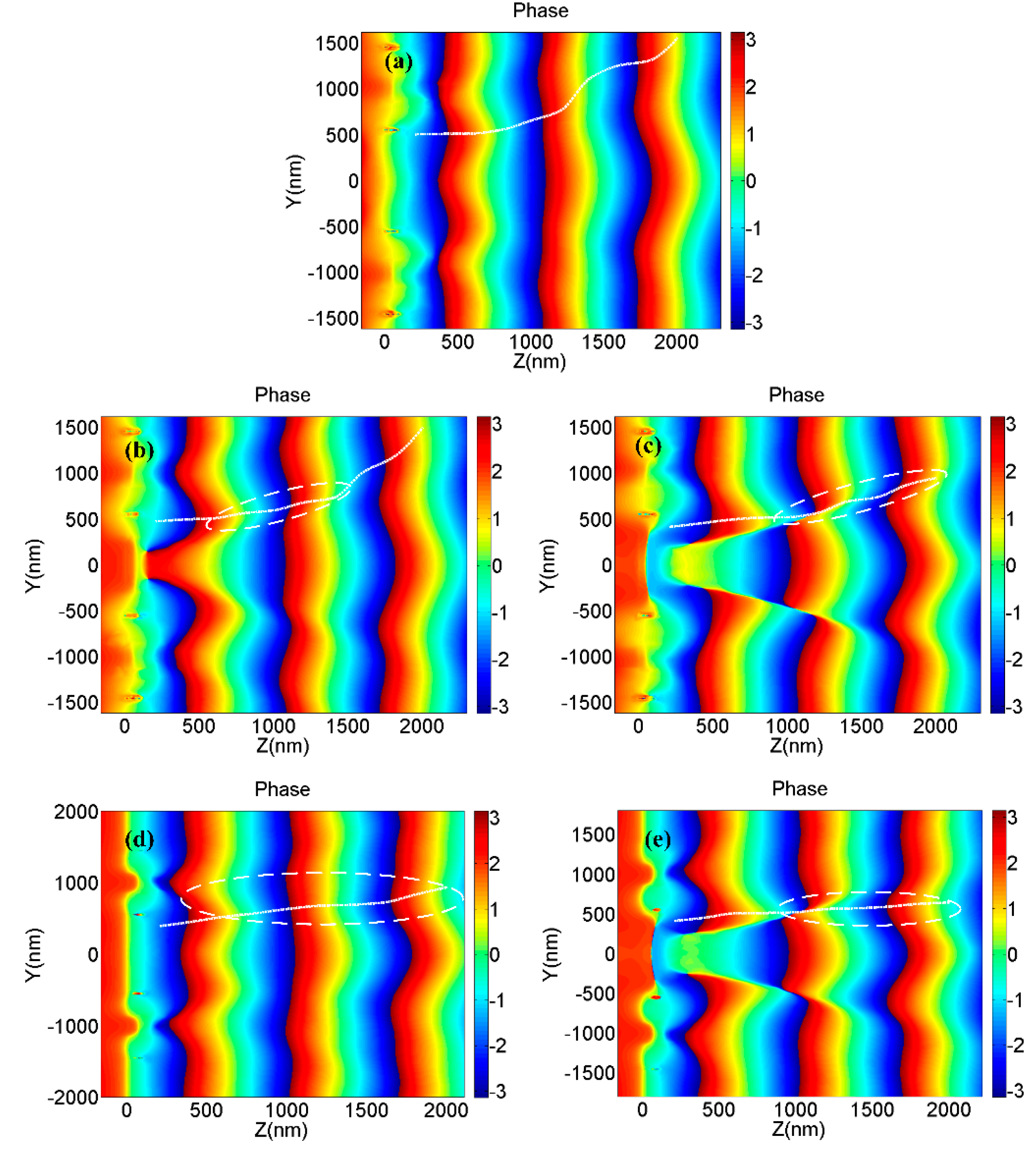
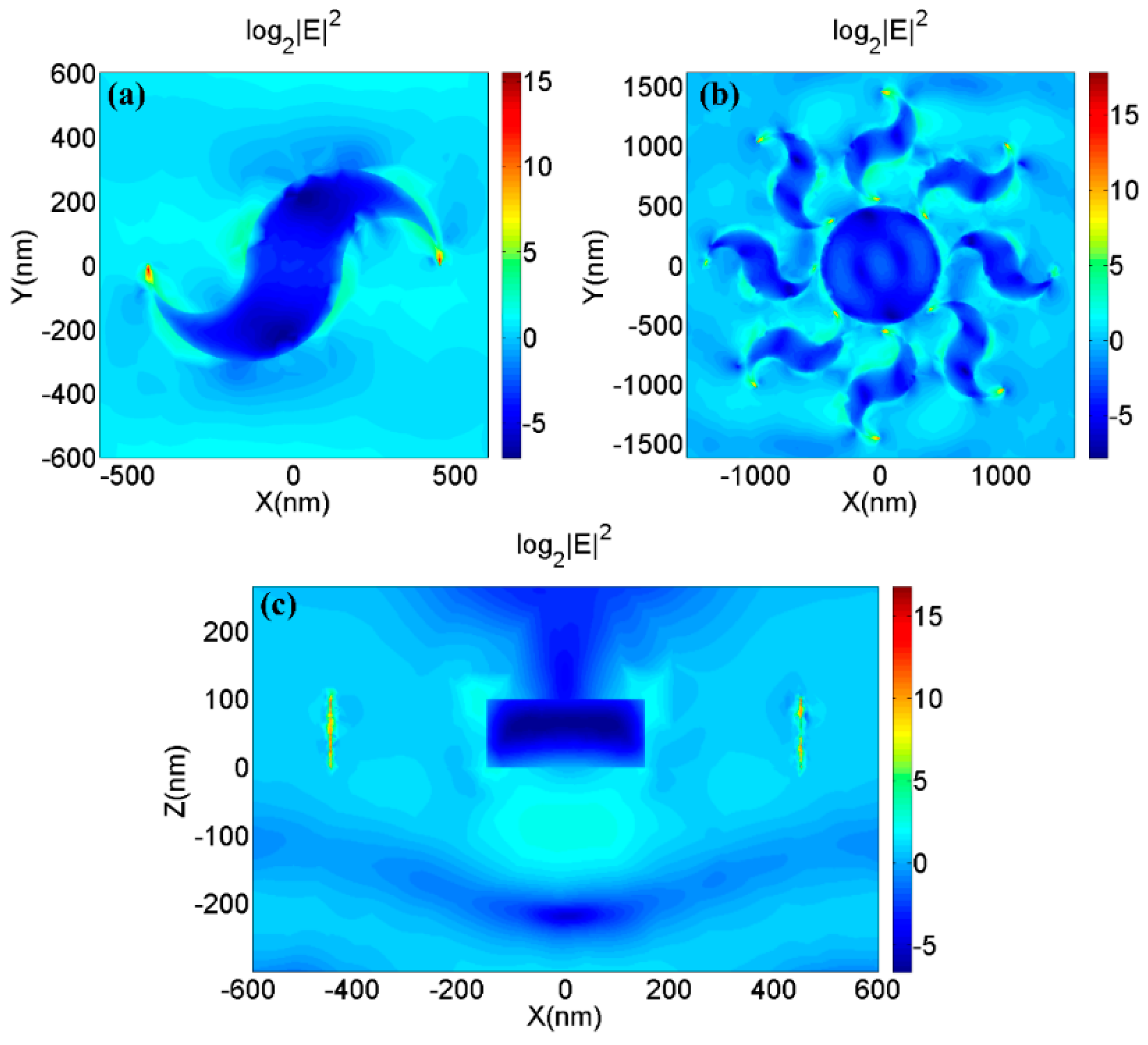
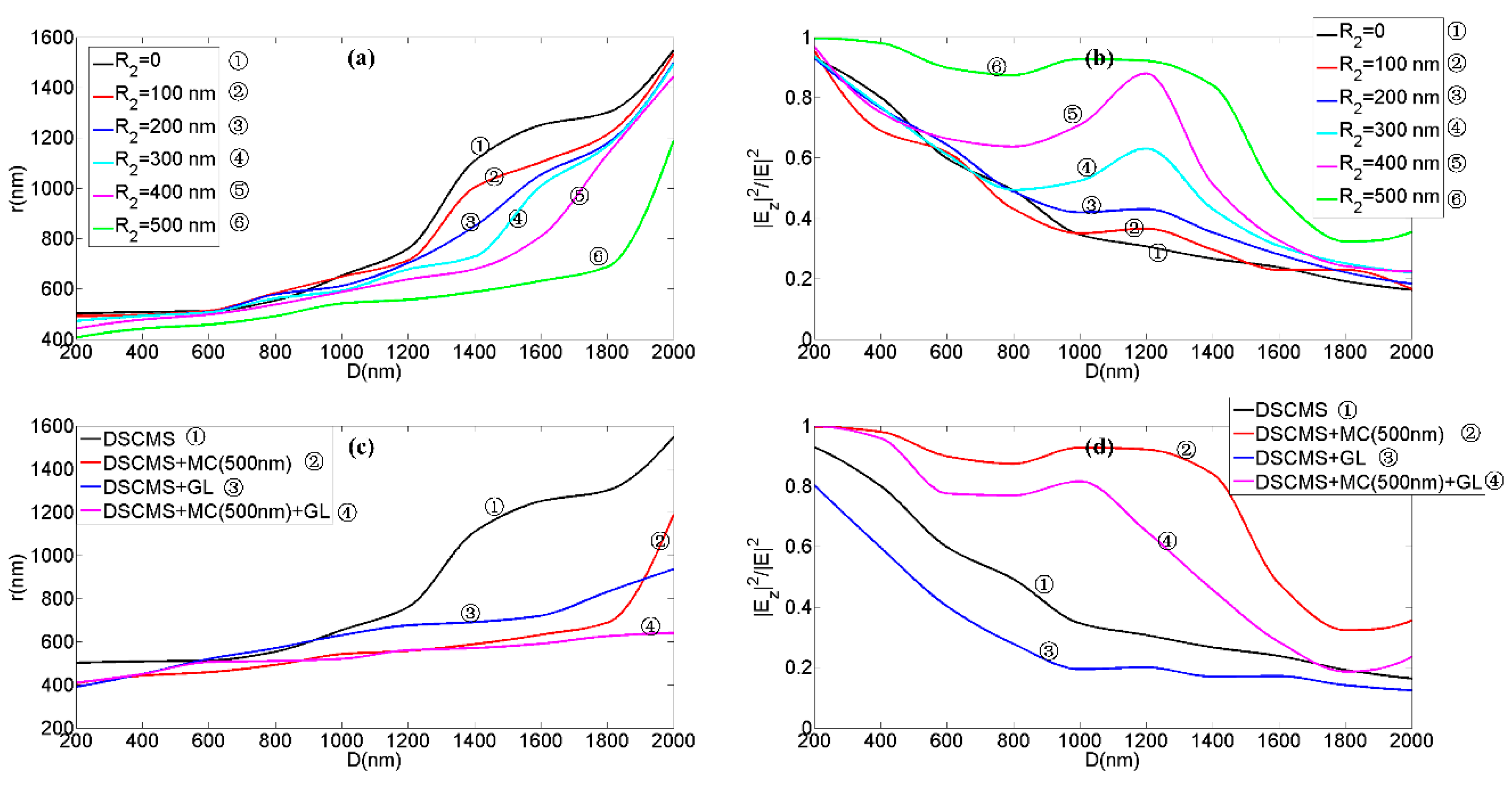

© 2019 by the authors. Licensee MDPI, Basel, Switzerland. This article is an open access article distributed under the terms and conditions of the Creative Commons Attribution (CC BY) license (http://creativecommons.org/licenses/by/4.0/).
Share and Cite
Yang, Z.; Kuang, D. Visible-broadband Localized Vector Vortex Beam Generator with a Multi-structure-composited Meta-surface. Nanomaterials 2019, 9, 166. https://doi.org/10.3390/nano9020166
Yang Z, Kuang D. Visible-broadband Localized Vector Vortex Beam Generator with a Multi-structure-composited Meta-surface. Nanomaterials. 2019; 9(2):166. https://doi.org/10.3390/nano9020166
Chicago/Turabian StyleYang, Zhuo, and Dengfeng Kuang. 2019. "Visible-broadband Localized Vector Vortex Beam Generator with a Multi-structure-composited Meta-surface" Nanomaterials 9, no. 2: 166. https://doi.org/10.3390/nano9020166
APA StyleYang, Z., & Kuang, D. (2019). Visible-broadband Localized Vector Vortex Beam Generator with a Multi-structure-composited Meta-surface. Nanomaterials, 9(2), 166. https://doi.org/10.3390/nano9020166




